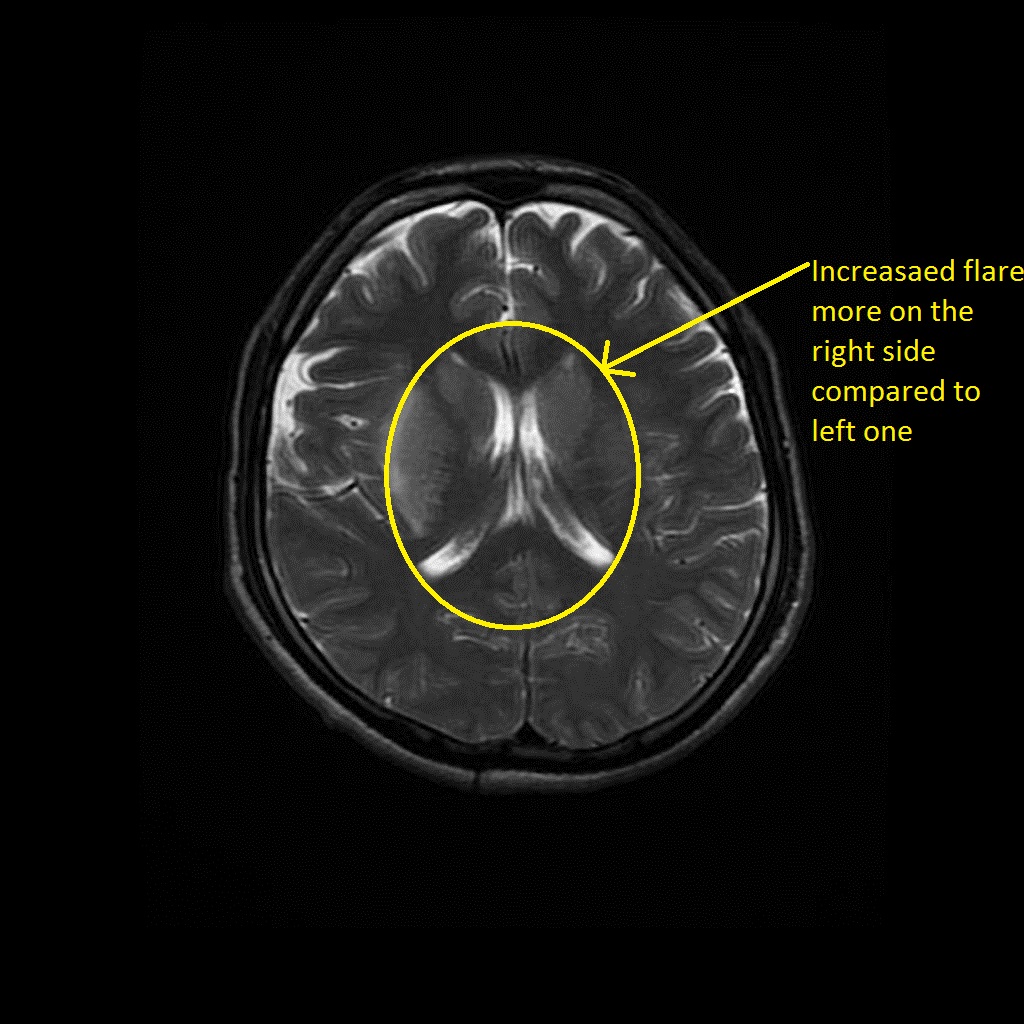Rabies MRI: Difference between revisions
Jump to navigation
Jump to search
Usama Talib (talk | contribs) (Created page with "__NOTOC__ {{Rabies}} {{CMG}}; {{AE}} ==Overview== There are no MRI findings associated with [disease name]. OR [Location] MRI may be helpful in the diagnosis of [disease...") |
m (Bot: Removing from Primary care) |
||
| (17 intermediate revisions by 2 users not shown) | |||
| Line 2: | Line 2: | ||
{{Rabies}} | {{Rabies}} | ||
{{CMG}}; {{AE}} | {{CMG}}; {{AE}} {{IQ}} | ||
==Overview== | ==Overview== | ||
Findings on [[Magnetic resonance imaging|MRI]] suggestive of rabies include areas of increased [[Magnetic resonance imaging|T2]] intensity (flare) may be seen in [[hippocampus]], [[hypothalamus]], and [[brainstem]]. | |||
[ | |||
==MRI== | ==MRI== | ||
Findings on [[Magnetic resonance imaging|MRI]] suggestive of rabies include: | |||
*Areas of increased [[Magnetic resonance imaging|T2]] signaling may be seen in:<ref name="pmid15956158">{{cite journal |vauthors=Burton EC, Burns DK, Opatowsky MJ, El-Feky WH, Fischbach B, Melton L, Sanchez E, Randall H, Watkins DL, Chang J, Klintmalm G |title=Rabies encephalomyelitis: clinical, neuroradiological, and pathological findings in 4 transplant recipients |journal=Arch. Neurol. |volume=62 |issue=6 |pages=873–82 |year=2005 |pmid=15956158 |doi=10.1001/archneur.62.6.873 |url=}}</ref> | |||
**[[Hippocampus]] | |||
*[ | **[[Hypothalamus]] | ||
**[ | **[[Brainstem]] | ||
**[ | * Rabies [[encephalitis]] may involve | ||
**[ | ** Increased T2 signal predilection for the [[basal ganglia]], [[thalami]], [[Hypothalamus|hypothalami]], [[brainstem]], [[limbic system]], and [[spinal cord]] as well as the [[frontal]] and [[Parietal lobe|parietal lobes]] | ||
* In [[paralytic]] rabies, involvement of the [[spinal cord]] and [[medulla]] may be more pronounced | |||
* | <br clear="left" /> | ||
[[File:Rabies-encephalomyelitis.jpg|center|500px|thumb|Case courtesy of- Case courtesy of Dr Nafisa Shakir Batta, Radiopaedia.org, rID: 37813]] | |||
[[File:Rabies-encephalomyelitis (1).jpg|center|700px|thumb|Case courtesy of- Case courtesy of Dr Nafisa Shakir Batta, Radiopaedia.org, rID: 37813]] | |||
<br clear="left" /> | |||
==References== | ==References== | ||
| Line 35: | Line 27: | ||
{{WH}} | {{WH}} | ||
{{WS}} | {{WS}} | ||
[[Category:(name of the system)]] | [[Category:(name of the system)]] | ||
[[Category:Infectious disease]] | |||
[[Category:Medicine]] | |||
Latest revision as of 23:56, 29 July 2020
|
Rabies Microchapters |
|
Diagnosis |
|---|
|
Treatment |
|
Case Studies |
|
Rabies MRI On the Web |
|
American Roentgen Ray Society Images of Rabies MRI |
Editor-In-Chief: C. Michael Gibson, M.S., M.D. [1]; Associate Editor(s)-in-Chief: Iqra Qamar M.D.[2]
Overview
Findings on MRI suggestive of rabies include areas of increased T2 intensity (flare) may be seen in hippocampus, hypothalamus, and brainstem.
MRI
Findings on MRI suggestive of rabies include:
- Areas of increased T2 signaling may be seen in:[1]
- Rabies encephalitis may involve
- Increased T2 signal predilection for the basal ganglia, thalami, hypothalami, brainstem, limbic system, and spinal cord as well as the frontal and parietal lobes
- In paralytic rabies, involvement of the spinal cord and medulla may be more pronounced


References
- ↑ Burton EC, Burns DK, Opatowsky MJ, El-Feky WH, Fischbach B, Melton L, Sanchez E, Randall H, Watkins DL, Chang J, Klintmalm G (2005). "Rabies encephalomyelitis: clinical, neuroradiological, and pathological findings in 4 transplant recipients". Arch. Neurol. 62 (6): 873–82. doi:10.1001/archneur.62.6.873. PMID 15956158.